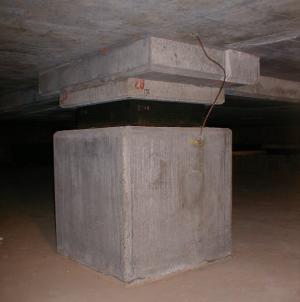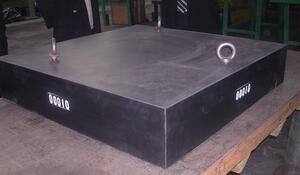Steel-rubber bed for ITER
ITER will be the first tokamak bedded on a soft pillow. In order to assure safe operations at all times, even in the event of an earthquake, ITER will be placed on 560 pads made of elastomer, an elastic polymer, and steel.
According to the Global Seismic Hazard Map, the ITER site is situated in a low to moderate seismic area. It sits on a limestone bedrock close to the confluence of the Durance and the Verdon rivers. Severe earthquakes are rare in the region—yet they have happened: on 11 June 1909, an earthquake measuring 6.2 on the Richter Scale, the strongest ever recorded in metropolitan France, made the earth tremble and destroyed numerous houses in Lambesc, a small village between Aix-en-Provence and Salon—de-Provence. In what was then a sparsely-populated area, 46 people died, another 250 were wounded, and approximately 2,000 buildings were damaged. Geologists later blamed the rupture of the Trévaresse Ridge for the disaster, a WNW-trending, southerly-verging fault-propagation fold developed during late Miocene.
An earthquake of that strength is unlikely to reoccur during the life cycle of the ITER facility. Nevertheless, the ITER Organization as the operator of a nuclear facility has to guarantee safe operation under any circumstance. In order to provide seismic isolation, the ITER Tokamak Complex, including the tokamak building itself, the diagnostic building and the tritium plant, will be seated on a bed made out of 560 spring-like rubber pads or bearings as they are officially called. "The reason to place the whole complex on a single foundation is to minimize any relative displacement of the various pipes, ducts and cooling water supply running between the three buildings in the case of a seismic event," says Laurent Patisson, ITER Section Leader for Nuclear Buildings.
The use of anti-seismic pads is a common technique for damping bridges, tall buildings and some fission reactors. ITER will be the first fusion device sitting on such "cushions." The pads developed for ITER are square shaped and approximately 0.90 x 0.90 m. They form a sort of "sandwich" comprising alternate layers of elastomer and metal plate.
The height of each "sandwich" is approximately 20 centimetres. They will rest on concrete columns each 1.8 metres high. Some 560 of them will be distributed throughout the Tokamak Complex foundation raft so as to best match a uniform vertical load to be supported. An appropriate minimum distance is left around the pads to allow for regular inspection and the possible replacement of bearing pads. In total, a two-metre clearance height is thus provided in the "basement," allowing accessibility for inspection and maintenance. "This is a lesson learned from former projects," says Patisson. "There are cases when there was not enough room provided for maintenance access, so the workers had to roll in the cavern underneath the concrete, lying on their backs looking up."
At the end of 2005, the European Fusion Development Agreement (EFDA) jointly with the Jules Horowitz Reactor, currently under construction on the CEA site in Cadarache, launched a qualification program with a series of tests that were performed throughout 2006 and 2007. The design of the bearings is currently under its final review by the ITER Organization and the Domestic Agencies. It will then be submitted to the Nuclear Safety Authority in the framework of the licensing process.



